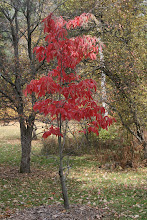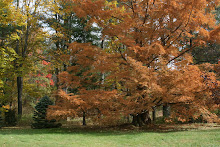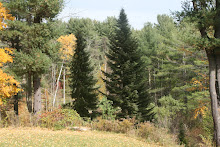
Metasequoia branch damaged and removed
An early heavy snow blew in on Saturday October 29, 2011 and left a lot more damage than one would think to the rare collection of trees and scrubs at Pine Hollow Arboretum. The storm was much lighter in the Albany, NY area than in other parts of the Northeast with millions without power due to fallen limbs and trees in the Middle Atlantic and New England States. Only three to five inches of wet snow fell on lower elevations, such as the Slingerlands, NY area where Pine Hollow Arboretum is located. As with all natural phenomenon the storm damage gave us the opportunity to learn from it as well as to see once again an illustration of Nature's landscape shaping ability. According to John Abbuhl, although there was significant damage to a number of our large trees, there does not seem to be any fatal blows struck. Although now shaped differently and in some cases topped-off, all the trees are expected to sprout new growth and continue to thrive. Because their needles had not yet dropped there was damage to a number of lower and upper branches on our big metasequoia in The Metasequoia Field and 80% of the tallest Fastigate Bald Cypress broke off. The top of a Sweetgum and a Sourwood that was in beautiful fall foliage were damaged. The Sourwood was about 12ft. high and lost one of its two double trunks. In front of the VISITOR CENTER more than 75% of a hybrid Kousa and American Dogwood broke from the weight of the wet snow.

damage on hybrid of Kousa and American dogwood
Something that John
Abbuhl noticed is quite interesting and points out again the specialness of the Pine Hollow Arboretum landscape. John said there was almost no damage to pine or fir branches. He said the White Pine had already had its needle drop with approximately 50% of needles being shed.
Blackgum leaves had dropped and that species had almost no damage from the storm. The oak trees are strong and could take the snow weight without breaking branches.
In fact, there was almost no limb loss on native trees. I take that to show the adaptation of the native species had allowed them to better deal with unexpected but not unknown variation in the usual weather patterns. Although we are impressed with the
uniqueness and marvel that species from all over the world can survive at Pine Hollow Arboretum. It is also important to recognize these "special visitors" might need special care to keep them healthy and growing.
---Alan
Casline
 Metasequoia branch damaged and removed
Metasequoia branch damaged and removed damage on hybrid of Kousa and American dogwood
damage on hybrid of Kousa and American dogwood










